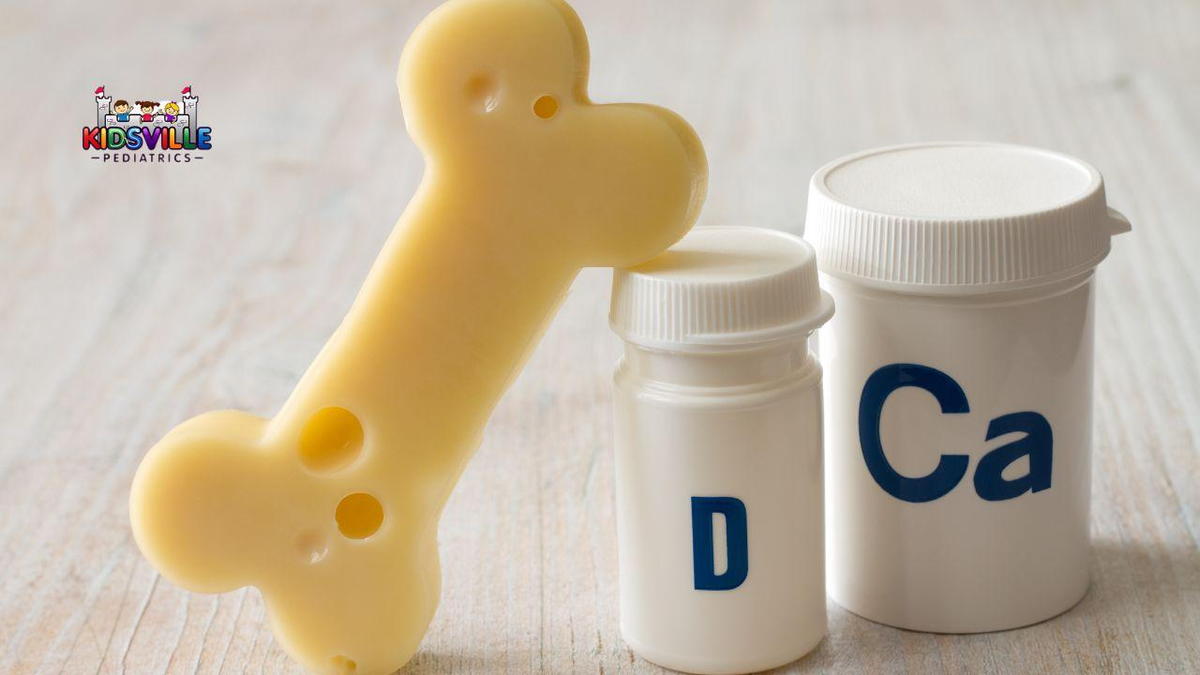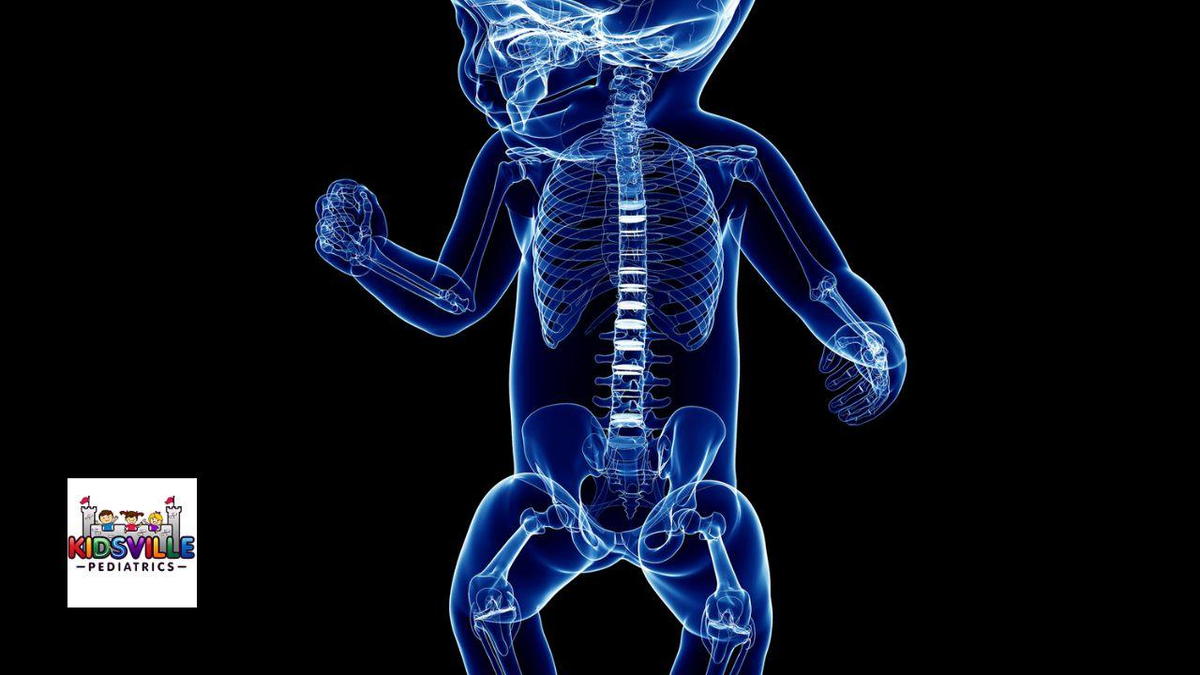
Ensuring that your child grows up strong and healthy is one of the most important tasks you have as a parent. Among the various nutrients essential for your child's development, calcium stands out as a key player in building strong, resilient bones. At Kidsville Pediatrics McKinney, we understand the critical role that calcium plays in your child's overall health, particularly during their formative years.
As your child grows, their bones are constantly developing, and calcium is the vital mineral that helps fortify them. But how do you ensure your child is getting enough calcium? And what are the potential long-term impacts if they don’t? These are questions every parent should consider when planning meals, snacks, and daily routines for their little ones.
Understanding the importance of calcium and how it contributes to your child’s bone health is crucial. By fostering healthy habits early on, you’re setting the foundation for strong bones that will support your child throughout their life.
In this guide, we'll explore why calcium is so important for growing kids and how you can make sure your child is getting enough of it. Whether it's through diet, supplements, or daily activities, there are simple steps you can take to promote strong bones and prevent issues later in life. Kidsville Pediatrics McKinney is here to support you every step of the way, providing expert advice and care tailored to your child’s needs.
The Role of Calcium in Bone Development During Childhood

Bones do more than just support your child’s body; they protect vital organs, anchor muscles, and store essential minerals like calcium. Building strong bones during childhood and adolescence sets the foundation for a lifetime of good health.
At Kidsville Pediatrics, we know how important it is to prioritize bone health, and we’re here to help you make the best decisions for your child, from their toddler years through their teenage milestones. As the best pediatrician McKinney, TX healthcare experts, we focus on ensuring that your child's bones develop properly and stay strong as they grow.
Your child's bones are constantly changing. As they grow, new bone tissue is made faster than old bone tissue is broken down. This process is most active during childhood and adolescence, which means these years are critical for building up bone mass. Most people reach their peak bone mass by around age 30, after which bone remodeling continues but at a slower pace. If your child builds strong bones now, they’ll have a better chance of avoiding osteoporosis—a condition that makes bones weak and prone to fractures—later in life.
The higher the bone mass your child builds during their younger years, the more "bone in the bank" they have for the future, making it less likely they’ll face bone issues as they age.
Key Factors That Affect Your Child’s Bone Health
As parents, understanding the factors that influence your child's bone health can help you take proactive steps to support their growth.
1. Calcium is Key
Calcium is essential for building strong bones. A diet low in calcium can lead to weaker bones and an increased risk of fractures. Ensuring your child, whether a toddler or a teenager, gets enough calcium through their diet or supplements is vital for their bone development.
2. Encourage Physical Activity
Regular physical activity is crucial for bone strength at every age. Kids and teens who are physically active generally have stronger bones. Encourage your child to participate in weight-bearing activities, such as running, jumping, or sports, to promote bone health.
3. Avoid Tobacco and Excessive Alcohol
While these may be concerns for older teens, it’s never too early to educate your children about the dangers of tobacco and excessive alcohol use. Both can have a negative impact on bone health and increase the risk of osteoporosis later in life.
4. Monitor Hormone Levels
Hormonal changes, especially during puberty, can significantly impact bone health. Low estrogen in girls and low testosterone in boys can lead to bone loss. Ensuring that your child’s hormonal health is on track is essential during their teenage years.
5. Watch for Eating Disorders and Nutrient Absorption Issues
Nutrient absorption and eating disorders , such as celiac disease, can weaken bones in both young children and teenagers. Monitoring your child's eating habits and overall health is crucial to ensure they are receiving the necessary nutrients for strong bone development.
How Kidsville Pediatrics McKinney Can Support Your Child’s Bone Health
At Kidsville Pediatrics, we’re dedicated to helping your child build and maintain strong bones at every stage of their growth. We also provide comprehensive care that includes nutritional guidance, recommendations for physical activity, and regular check-ups to monitor bone health. Whether your child is a toddler or a teenager, we work closely with you to create a personalized plan that supports their bone development and overall health.
Daily Calcium Requirements for Growing Kids

Nearly all (98%) of the calcium in the body is stored in the bones, where it acts as a reservoir to maintain calcium homeostasis. More than 99% of the body's calcium is found in the form of calcium hydroxyapatite, a compound stored in the bones and teeth. Unlike teeth, bones undergo continuous remodeling, where calcium is resorbed and deposited into new bone. This ongoing process is essential for changing bone size during growth, repairing damage, maintaining calcium levels in the blood, and providing a source of other vital minerals.
At birth, a child's body contains approximately 26 to 30 grams of calcium. This amount quickly increases after birth, reaching about 1,200 grams in women and 1,400 grams in men by adulthood. While these levels remain constant in men, they begin to decrease in women due to increased bone remodeling triggered by reduced estrogen production at menopause.
Calcium Absorption: How It Changes Over Time
Calcium absorption from food varies depending on intake. For example, when calcium intake is about 200 mg/day, absorption is approximately 45%. However, when calcium intake exceeds 2,000 mg/day, absorption drops to about 15%. Age also plays a role in how well your child absorbs dietary calcium. Infants and young children, who require substantial amounts of calcium to build bone, have a net absorption rate as high as 60%. This rate decreases to about 25% in adulthood and continues to decline with age.
As parents, understanding these absorption rates can help you ensure that your child receives adequate calcium during their crucial growth years. The best pediatrician in McKinney, TX, can provide guidance on the right calcium intake for your child based on their age, diet, and overall health.
Monitoring Calcium Levels and Bone Health
Calcium levels in the body can be measured in serum or plasma, with normal serum levels ranging from 8.8 to 10.4 mg/dL. However, these levels do not necessarily reflect your child's nutritional status due to tight homeostatic control. The biologically active form of calcium, known as ionized calcium, can also be measured in serum. The normal range for ionized calcium is 4.6 to 5.3 mg/dL. Dual x-ray absorptiometry testing of bone mineral density is another method used to assess calcium status over a lifetime, as the skeleton stores nearly all the calcium in the body.
Calcium Recommendations: Ensuring Adequate Intake
To help parents plan their child's diet, the Dietary Reference Intakes (DRIs) provide recommended calcium levels for different age groups. For example, the Recommended Dietary Allowance (RDA) for children aged 1-3 years is 700 mg/day, while for those aged 9-18 years, it's 1,300 mg/day. These recommendations are designed to promote bone accumulation and positive calcium balance during the critical growth years.
At Kidsville Pediatrics, your child's health is our priority. We are here to support you in ensuring your child receives the right amount of calcium to build strong, healthy bones. Schedule a visit with us, and let’s work together to keep your child’s bones strong and resilient as they grow.
Food High in Calcium
Dairy Products: Your Calcium Powerhouses
Milk, yogurt, and cheese are classic calcium-rich foods that are staples in many households. These foods not only provide a high amount of calcium but also offer other essential nutrients like vitamin D and protein, which help support overall growth and development. In the United States, about 72% of calcium intake comes from dairy products, making them the primary source of this mineral for most people.
Non-dairy Sources: More Than Just Milk
If your child is lactose intolerant or you prefer to limit dairy, there are plenty of nondairy options that can help meet calcium needs. Foods like canned sardines and salmon (with bones), kale, broccoli, and Chinese cabbage (bok choy) are excellent sources of calcium. Additionally, many grains, although not particularly high in calcium, contribute to your daily intake simply because they are consumed so frequently. Some foods, such as fruit juices, tofu, and ready-to-eat cereals, are fortified with calcium, providing an extra boost.
Maximizing Calcium Absorption
Calcium absorption can vary depending on the food source. For example, about 30% of calcium from dairy products and fortified foods is absorbed by the body. However, certain plant-based foods contain compounds like oxalic acid and phytic acid, which can bind to calcium and reduce its absorption. Spinach, for instance, has a calcium absorption rate of just 5%, while milk has a much higher absorption rate of 27%. Despite this, when you eat a variety of foods, these interactions usually have little impact on overall calcium intake.
Calcium Supplements: When Food Isn’t Enough
For some, getting enough calcium through diet alone can be challenging. In such cases, calcium supplements may be necessary. Calcium carbonate and calcium citrate are the most common forms found in supplements. Calcium carbonate is more easily absorbed when taken with food, while calcium citrate can be taken on an empty stomach. It's essential to follow the dosage instructions, as your body absorbs calcium more effectively in smaller doses of 500 mg or less.
Be Mindful of Potential Side Effects
While calcium supplements are beneficial, they can cause gastrointestinal side effects such as gas, bloating, and constipation. Calcium carbonate is more likely to cause these symptoms, particularly in older adults with lower stomach acid levels. If your child experiences these issues, consider switching to a different form of calcium, taking smaller doses throughout the day, or ensuring the supplement is taken with meals.
How Vitamin D Enhances Calcium Absorption for Stronger Bones

Vitamin D and calcium are crucial nutrients to maintain healthy bones and health. It's important to ensure your child is getting enough of these nutrients to support their growth and development.
Vitamin D acts as a hormone in the body, helping with the absorption of calcium and phosphorus, essential for bone health. It also plays a crucial role in muscle movement, nerve communication, and immune system responses. Calcium is a mineral that helps with muscle function, nerve signaling, and blood vessel flow, among other vital processes.
Without sufficient vitamin D or calcium, the body can develop a condition called hyperparathyroidism, where the parathyroid glands produce too much hormone, leading to weakened bones (osteoporosis) and an increased risk of fractures. Other issues stemming from deficiencies include skeletal deformities, such as rickets in young children, and muscle weakness, particularly in children and the elderly.
To ensure your child’s bones stay strong, any McKinney pediatrician may recommend following the guidelines set by The Endocrine Society and the Institute of Medicine. These organizations provide recommended daily allowances (RDA) for both vitamin D and calcium based on age and health status. For example, children aged 1-3 years should get 700 mg of calcium and 600 IU of vitamin D daily.
Sources of Vitamin D
Your body produces vitamin D when exposed to sunlight, but factors such as living in northern regions, using sunscreen, or having darker skin can reduce production. To ensure adequate vitamin D levels, you might need supplements, especially if dietary sources are insufficient. Foods like fortified milk, orange juice, and fatty fish are good sources.
Managing Deficiencies
If your child has a vitamin D deficiency, their McKinney pediatrician might prescribe higher doses of vitamin D for a short period to correct the deficiency. Regular check-ups and lab tests are crucial to monitor and adjust their nutrient intake as needed.
Signs of Calcium Deficiency in Children and How to Address It

Hypocalcemia is a condition where your baby has too little calcium in their blood. Calcium is crucial for proper heart and muscle function, as well as for healthy bone development. If you’re working with McKinney pediatricians, they will closely monitor your baby’s calcium levels, especially if your child is at risk.
Causes of Hypocalcemia
In newborns, hypocalcemia can be caused by several factors, including premature birth, infections, maternal diabetes, and certain medications. A vitamin D deficiency, particularly in breastfed babies who aren’t receiving vitamin D supplements, can also lead to low calcium levels. Less common causes include hyperparathyroidism, a disorder of the pituitary gland, and pseudohypoparathyroidism, a genetic condition that mimics hypoparathyroidism.
Recognizing Symptoms
Often, hypocalcemia shows no symptoms. However, if symptoms do appear, they might include short stature, dry skin, dry hair, brittle nails, muscle cramps, tingling in the fingers and toes, cataracts, weakened tooth enamel, and even seizures. If you notice any of these signs, it’s crucial to consult your McKinney pediatricians immediately.
Diagnosing Hypocalcemia
Diagnosing hypocalcemia typically involves a blood test to check calcium levels. Your pediatrician might also measure blood levels of parathyroid hormone and vitamin D to pinpoint the cause of the low calcium levels.
Treatment and When to Seek Help
Treatment involves restoring normal calcium levels through calcium supplements. Addressing the condition early is essential because prolonged hypocalcemia can lead to poor bone formation and brittle bones that are prone to fractures. Vitamin D supplements might also be recommended to support calcium absorption.
If you notice any symptoms of calcium deficiency in your child, don’t hesitate to reach out to your pediatrician for advice and treatment. Your McKinney pediatricians are here to ensure your baby’s health and development are on the right track.
You may schedule an appointment online: https://www.kidsvillepeds.com/appointment/ Or visit/call our clinics: Kidsville Pediatrics Mansfield TX: 682-341-3910; 1759 Broad Park Circle S, Suite 201 & 205, Mansfield, TX Kidsville Pediatrics Southlake: 682-345-8010; 2813 W. Southlake Blvd Suite 100 Southlake, TX Kidsville Pediatrics McKinney: 469-885-9400; 5881 Virginia Pkwy. Suite 300 Mckinney, TX |

